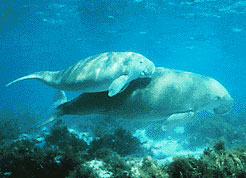Order: Sirenia (manatees and dugongs)

Sirenia is an order of fully aquatic, herbivorous mammals that inhabit rivers, estuaries, coastal marine waters, swamps, and marine wetlands. All four species are endangered.
- Family: Dugongidae
This is a list of the mammal species recorded in the Solomon Islands. The geographical area covered by this article refers to the archipelago of the Solomon Islands, which includes Bougainville, an autonomous region of Papua New Guinea, as well as the group of islands that make up the nation state of Solomon Islands. Within this area there are sixty-three mammal species of which four are critically endangered, one is endangered, and fifteen are vulnerable.
Three of the species listed for the Solomon Islands are considered to be extinct. [1]
The marine mammals of the order Cetacea that have been identified in the Pacific Ocean is described in the literature review by Miller (2006) [2] and by the Secretariat of the Pacific Regional Environment Programme (SPREP). [3] A revision of the list of cetaceans reported in the ocean surrounding the Solomon Islands was carried by Miller (2009). [4]
The following tags are used to highlight each species' conservation status as assessed by the International Union for Conservation of Nature:
| EX | Extinct | No reasonable doubt that the last individual has died. |
| EW | Extinct in the wild | Known only to survive in captivity or as a naturalised populations well outside its previous range. |
| CR | Critically endangered | The species is in imminent risk of extinction in the wild. |
| EN | Endangered | The species is facing an extremely high risk of extinction in the wild. |
| VU | Vulnerable | The species is facing a high risk of extinction in the wild. |
| NT | Near threatened | The species does not meet any of the criteria that would categorise it as risking extinction but it is likely to do so in the future. |
| LC | Least concern | There are no current identifiable risks to the species. |
| DD | Data deficient | There is inadequate information to make an assessment of the risks to this species. |

Sirenia is an order of fully aquatic, herbivorous mammals that inhabit rivers, estuaries, coastal marine waters, swamps, and marine wetlands. All four species are endangered.
Rodents make up the largest order of mammals, with over 40% of mammalian species. They have two incisors in the upper and lower jaw which grow continually and must be kept short by gnawing. Most rodents are small though the capybara can weigh up to 45 kg (99 lb).
The bats' most distinguishing feature is that their forelimbs are developed as wings, making them the only mammals capable of flight. Bat species account for about 20% of all mammals.
The Diprotodontia are an order of about 125 species of marsupial mammals including the kangaroos, wallabies, possums, koala, wombats, and many others.


The order Cetacea includes whales, dolphins and porpoises. They are the mammals most fully adapted to aquatic life with a spindle-shaped nearly hairless body, protected by a thick layer of blubber, and forelimbs and tail modified to provide propulsion underwater.